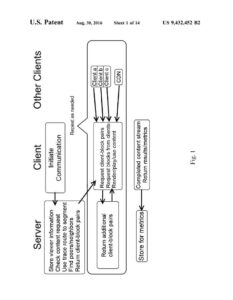COOPERATIVE ENTERTAINMENT, INC v KOLLECTIVE TECHNOLOGY, INC, FEDERAL CIRCUIT 2022 (SOFTWARE PATENTS)
 At the pleadings stage, all that is required to survive a motion to dismiss based on Alice are plausible allegations in a complaint that the claims are patent-eligible.
At the pleadings stage, all that is required to survive a motion to dismiss based on Alice are plausible allegations in a complaint that the claims are patent-eligible.
The District Court for the Northern District of California’s dismissed Cooperative’s complaint for failure to state a claim as it found all claims of U.S. Patent No. 9,432,452 patent ineligible under 35 U.S.C. § 101
U.S. Patent No. 9,432,452 is a software patent that relates to structuring a peer-to-peer dynamic network for distributing large files, such as videos and video games. In prior art systems, video streaming was controlled by content distribution networks (CDNs), where content was “distributed directly from the CDN server originating the content.” The patent, in contrast, claims methods and systems for a network in which content distribution occurs “outside controlled networks and/or [CDNs],” i.e., outside a “static network of controlled systems.” It does this with dynamic P2P networks comprising “peer nodes,” i.e., nodes consuming the same content contemporaneously, that transmit content directly to each other instead of receiving content from the CDN. To facilitate content distribution, the claimed P2P networks use “content segmentation” in which a video file, for example, is segmented into smaller clips and distributed piecemeal. As a result, viewers can obtain individual segments as needed, preferably from other viewers. Content is segmented using several techniques, including “CDN address resolution, trace route to CDN and the P2P server manager, dynamic feedback from peers reporting traffic rates between individual peer and its neighbors, round-robin, other server side scheduling/resource allocation techniques, and combinations thereof.” Claim 1 is representative and recites:
1. A system for virtualized computing peer based content sharing comprising:
- at least one content delivery server computer constructed and configured for electrical connection and communication via at least one communications network; and
- at least one peer-to-peer (P2P) dynamic network including a multiplicity of peer nodes, wherein the multiplicity of peer nodes consume the same content within a predetermined time, wherein the multiplicity of peer nodes are constructed and configured for electronic communication over the at least one P2P dynamic network, wherein the at least one P2P dynamic network is based on at least one trace route; wherein the multiplicity of peer nodes is distributed outside controlled networks and/or content distribution networks (CDNs) that are included within the at least one communications network;
- wherein the at least one content delivery server computer is operable to store viewer information, check content request, use the trace route to segment requested content, find peers, and return client-block pairs; wherein distribution of P2P content delivery over the at least one P2P dynamic network is based on content segmentation;
- wherein content segmentation is based on CDN address resolution, trace route to CDN and P2P server manager, dynamic feedback from peers reporting traffic rates between individual peer and its neighbors, round-robin and other server side scheduling/resource allocation techniques.
If you have read any of the other posts in Malhotra Law Firm’s History of Software Patents, you will be well aware that the Supreme Court has set forth a two-step framework for analyzing patent eligibility in Alice Corp. Pty. Ltd.
v. CLS Bank Int’l, First, in Alice Step 1, the Federal Circuit is to determine whether the claims at issue are directed to patent-ineligible concepts such as laws of nature, natural phenomena, and abstract ideas. If so, in Alice Step 2, the Federal Circuit is to examine the elements of each claim, considered both individually and as an ordered combination, for an “inventive concept” sufficient to transform the nature of the claim into a patent eligible application.
The district court held at Alice step one the “focus of the ’452 patent” is the abstract idea of “the preparation and transmission of content to peers through a computer network.” At Alice step two, the district court characterized the ’452 patent as “merely implement[ing] the abstract idea of preparing and
transmitting data over a computer network with generic computer components using conventional technology.”
According to the Federal Circuit, there are at least two alleged inventive concepts in claim 1 which should have precluded the district court’s holding on ineligibility. The first is the required dynamic P2P network wherein multiple peer nodes consume the same content and are configured to communicate outside the CDNs. The second requires trace routes be used in content segmentation.
The specification explains how claim 1’s dynamic P2P network structure is different from and improves upon the prior art, especially the structural limitation that the peer nodes consuming the same content be distributed outside a controlled network or a CDN. As a result, the invention of claim 1 by-passes any established or static content delivery network (CDN); advantageously, this saves time, improves redundancy, and also reduces or eliminates costs for content delivery over the CDN for the peer nodes.
The systems and methods of the invention provide for harnessing the content recipient devices to aggregate or assemble intelligent functionality of the devices unassociated with the content receipt, including but not limited to computational storage and processing capacity of the content recipient devices in the P2P dynamic network
Drawing all inferences in favor of Cooperative, as the Federal Circuit must do on a motion to dismiss, they concluded that claim 1 recites a specific technical solution that is an inventive concept: it recites a particular arrangement of peer nodes for distributing content “outside controlled networks and/or [CDNs].
Where a defendant tries to have your infringement suit thrown out, all you need are plausible Alice arguments. At this stage, it is too late to change the patent document. If you need help protecting your software, contact Malhotra Law Firm, PLLC.